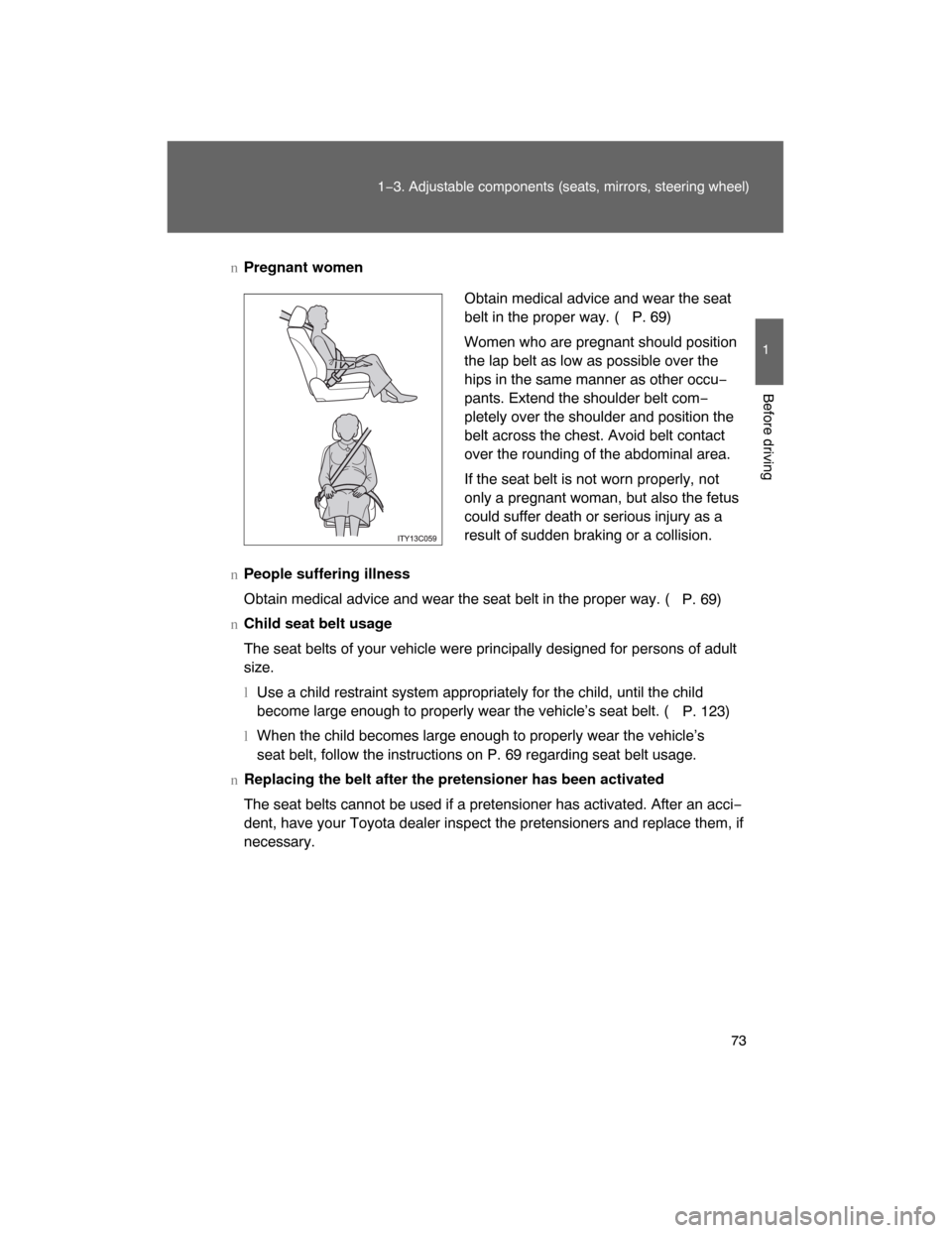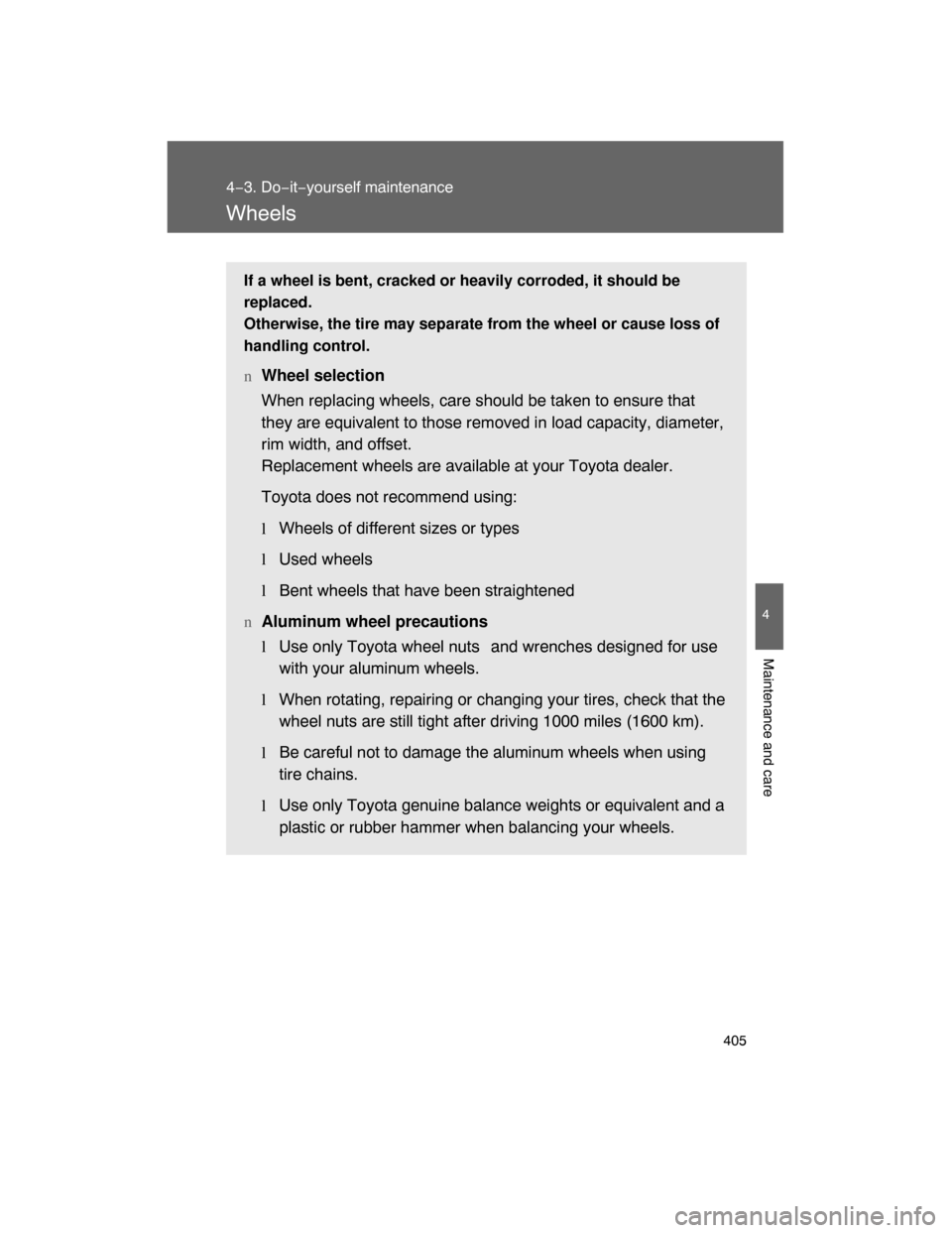2008 TOYOTA LAND CRUISER wheel size
[x] Cancel search: wheel sizePage 72 of 531

73
1−3. Adjustable components (seats, mirrors, steering wheel)
1
Before driving
nPregnant women
nPeople suffering illness
Obtain medical advice and wear the seat belt in the proper way. (
P. 69)
nChild seat belt usage
The seat belts of your vehicle were principally designed for persons of adult
size.
lUse a child restraint system appropriately for the child, until the child
become large enough to properly wear the vehicle’s seat belt. (
P. 123)
lWhen the child becomes large enough to properly wear the vehicle’s
seat belt, follow the instructions on P. 69 regarding seat belt usage.
nReplacing the belt after the pretensioner has been activated
The seat belts cannot be used if a pretensioner has activated. After an acci−
dent, have your Toyota dealer inspect the pretensioners and replace them, if
necessary.Obtain medical advice and wear the seat
belt in the proper way. ( P. 69)
Women who are pregnant should position
the lap belt as low as possible over the
hips in the same manner as other occu−
pants. Extend the shoulder belt com−
pletely over the shoulder and position the
belt across the chest. Avoid belt contact
over the rounding of the abdominal area.
If the seat belt is not worn properly, not
only a pregnant woman, but also the fetus
could suffer death or serious injury as a
result of sudden braking or a collision.
Page 205 of 531

207
2−4. Using other driving systems
2
When driving
CAUTION
nWhen the VSC is activated
The slip indicator light flashes and a warning buzzer sounds. Always drive
carefully.
Reckless driving may cause an accident. Exercise particular care when the
indicator light flashes and a buzzer sounds.
nReplacing tires
Make sure that all tires are of the
same size, brand, tread pattern and total
load capacity. In addition, make sure that the tires are inflated to the speci−
fied tire pressure level.
The Multi Terrain ABS and VSC will not function correctly if different tires are
fitted on the vehicle.
Contact your Toyota dealer for further information when replacing tires or
wheels.
NOTICE
nKDSS
In the following situations, there is the possibility that a system malfunction
has occurred, and drive comfort and the vehicle’s ability to travel on poor
road surfaces may be reduced. Take the vehicle to your Toyota dealer imme−
diately.
lWhen turning a corner, the vehicle’s body seems to roll further than nor−
mal.
l
If after the vehicle has been left in a slanted position for a long time, for
example with the wheels of one side parked on a curb, the vehicle does
not return to level when driving (the vehicle remains slanted to one side
after returning the vehicle to level ground).
Page 223 of 531

225
2−5. Driving information
2
When driving
CAUTION
nDriving with snow tires
Observe the following precautions to reduce the risk of accidents.
Failing to do so may result in a loss of vehicle control and cause death or
serious injury.
lUse tires of the size specified for your vehicle.
lMaintain the recommended level of tire inflation pressure.
lDo not drive in excess of 75 mph (120 km/h), regardless of the type of
snow tires being used.
lSnow tires should be installed on all wheels.
nDriving with tire chains
Observe the following precautions to reduce the risk of accidents.
Failing to do so may result in the vehicle being unable to be driven safely,
and may cause death or serious injury.
lDo not drive in excess of the speed limit specified for the tire chains being
used, or 30 mph (50 km/h), whichever is lower.
lAvoid driving on bumpy road surfaces or over potholes.
lAvoid sudden turns and braking, as use of chains may adversely affect
vehicle handling.
l
Slow down sufficiently before entering a curve to ensure that vehicle con−
trol is maintained.
Page 390 of 531

395
4−3. Do−it−yourself maintenance
4
Maintenance and care
Registering ID codes
The tire pressure warning valve and transmitter is equipped with a
unique ID code. When replacing a tire pressure warning valve and
transmitter, it is necessary to regi ster the ID code of tire pressure
warning valve and transmitter. Have the ID code registered by your
Toyota dealer.
n When to replace your vehicle’s tires
Tires should be replaced if:
lYou have tire damage such as cuts, splits, cracks deep enough to
expose the fabric or bulges indicating internal damage
lA tire goes flat repeatedly or c annot be properly repaired due to the
size or location of a cut or other damage
If you are not sure, consult with your Toyota dealer.
n Replacing tires and wheels
If the ID code of the tire pressure warning valve and transmitter is not
registered, the tire pre ssure warning system will not work properly. After
driving for about 20 minutes, the ti
re pressure warning light comes on
after blinking for 1 minute to indicate a system malfunction.
n Tire life
Any tire over 6 years old must be checked by a qualified technician even
if they have seldom or never been used or damage is not obvious.
n If the treadwears down below 0.16 in. (4 mm) on snow tires
The effectiveness of snow tires is lost.
Page 391 of 531

396 4−3. Do−it−yourself maintenance
nMaximum load of tire
Check that the maximum load of the re
placed tire is greater than 1/2 of
the Gross Axle Weight Ratings (GAWR) of either the front axle or the
rear axle, whichever is greater.
As for the maximum load of the tire, see the load limit at maximum cold
tire inflation pressure mentioned on the sidewall of the tire, and as for the
Gross Axle Weight Ratings (GAWR)
, see the Certification Label. ( P.
401, 507).
nTire types
1 Summer tires
Summer tires are high−speed performance tires best suited to highway
driving under dry conditions. Sinc
e summer tires do not have the same
traction performance as snow tire s, summer tires are inadequate for
driving on snow−covered or icy roads. For driving on snow−covered
roads or icy roads, the use of
snow tires is recommended. When
installing snow tires, be sure to replace all four tires.
2 All season tires
All season tires are designed to prov ide better traction in snow and to
be adequate for driving in most winter conditions, as well as for use
year round. All season tires, however, do not have adequate traction
performance compared with snow tires in heavy or loose snow. Also,
all season tires fall short in acceleration and handling performance
compared with summer tires in highway driving.
3Snow tires
For driving on snow−covered roads or icy roads, we recommend using
snow tires. If you need snow tires,
select tires of the same size, con−
struction and load capacity as the or iginally installed tires. Since your
vehicle has radial tires as original equipment, make sure your snow
tires also have radial construction. Do not install studded tires without
first checking local regulations for possible restriction. Snow tires
should be installed on all wheels. (
P. 222)
Page 394 of 531

399
4−3. Do−it−yourself maintenance
4
Maintenance and care
CAUTION
n Tire pressure warning system operation
The tire pressure warning system may not provide warning immediately
if a tire bursts or if
sudden air leakage occurs.
n When inspecting or replacing tires
Observe the following precautions to prevent accidents. Failure to do so
may cause damage to parts of the drive train, as well as dangerous han−
dling characteristics, which may le
ad to fatal or injury accidents.
lDo not mix tires of different makes, models, tread patterns or tread−
wear.
lDo not use tire sizes other than those recommended by Toyota.
lDo not mix radial, bias−belted, or bias−ply tires.
lDo not mix summer, all season and winter tires.
lDo not use tire that have been used on another vehicle.
Do not use tires if you do not know they were used previously.
n When initializing the tire pressure warning system
Do not press the tire pressure warning reset switch without first adjusting
the tire inflation pressure to the spec
ified level. Otherwise, the tire pres−
sure warning light may not come on ev en if the tire inflation pressure is
low, or it may come on when the tire
inflation pressure is actually normal.
NOTICE
n Repairing or replacing tires, wheels and tire pressure warning
valves and transmitters
When removing or fitting the wheels, tires or the tire pressure warning
valve and transmitter, contact your Toyota dealer as the tire pressure
warning valve and transmitter may be damaged if not handled correctly.
n To avoid damaging the tire pressure warning valves and transmit�
ters
Do not use liquid sealants on flat tires.
Page 400 of 531

405
4−3. Do−it−yourself maintenance
4
Maintenance and care
Wheels
If a wheel is bent, cracked or heavily corroded, it should be
replaced.
Otherwise, the tire may separate from the wheel or cause loss of
handling control.
nWheel selection
When replacing wheels, care should be taken to ensure that
they are equivalent to those removed in load capacity, diameter,
rim width, and offset.
Replacement wheels are available at your Toyota dealer.
Toyota does not recommend using:
lWheels of different sizes or types
lUsed wheels
l
Bent wheels that have been straightened
n
Aluminum wheel precautions
l
Use only Toyota wheel nuts and wrenches designed for use
with your aluminum wheels.
l
When rotating, repairing or changing your tires, check that the
wheel nuts are still tight after driving 1000 miles (1600 km).
lBe careful not to damage the aluminum wheels when using
tire chains.
lUse only Toyota genuine balance weights or equivalent and a
plastic or rubber hammer when balancing your wheels.
Page 401 of 531

406 4−3. Do−it−yourself maintenance
nWhen replacing wheels
The wheels of your Toyota are equipped with tire pressure warning valves
and transmitters that allow the tire pressure warning system to provide
advanced warning in the event of a loss in tire inflation pressure. Whenever
wheels are replaced, the tire pressure warning valves and transmitters must
be installed. (
P. 392)
CAUTION
nWhen replacing wheels
lDo not use wheels that are a different size from those recommended in the
Owner ’s Manual, as this may result in loss of handling control.
lNever use an inner tube in a leaking wheel which is designed for a tube−
less tire. Doing so may result in an accident, causing death or serious
injury.
NOTICE
nReplacing tire pressure warning valves and transmitters
lBecause tire repair or replacement may affect the tire pressure warning
valves and transmitters, make sure to have tires serviced by your Toyota
dealer or other qualified service shop. In addition, make sure to purchase
your tire pressure warning valves and transmitters at your Toyota dealer.
l
Ensure that only genuine Toyota wheels are used on your vehicle.
Tire pressure warning valves and transmitters may not work properly with
non−genuine wheels.